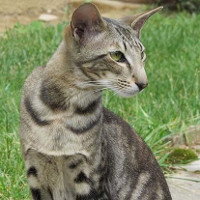Like the Siamese, Korat and Khao Manee, the Oriental originated in Thailand, where it was imported in 1850. It differs from these only in coat and eye color. All arrived in the UK in the late 19th century, but the British preferred the Siamese to the Oriental.
In the early days of Siamese breeding, the breed accepted all patterns, colorpoint and solid. In the 1920s, Siamese breeding clubs in Britain decided to concentrate solely on colorpoint, and other color varieties began to disappear. After the Second World War, breeding programs aimed at introducing chocolate color resulted in the reappearance of the solid pattern.
Initially, each new solid color became a new breed: Chestnut brown foreign, with its solid chocolate color, was the first breed recognized by the GCCF in 1958, followed by Lavender, with its solid lilac color5 , and Foreign white, the third recognized breed.
Breeders soon realized that it was unrealistic to continue with the "one color, one breed" model, given the large number of coat colors existing in cats. In the United Kingdom, it was decided to divide the Siamese breed into several breeds: colorpoint subjects remained Siamese, chocolate solids were Chestnut brown foreign, which was imported into the United States as Havana brown, foreigns represented non-chocolate solid colors and Oriental contained all other colors.
Across the Atlantic, the Americans adopted a simpler classification into two breeds: the Siamese, a colorpoint cat, and the Oriental shorthair, containing all other colors. The Governing Council of the Cat Fancy (GCCF) did not harmonize its classification with that of the USA until the 1990s, except for the Foreign white, which remains a breed in its own right in the UK.
In 1968, American breeders began breeding programs, favoring an extreme morphological type, close to today's Siamese, while the British preferred a moderate type. The CFA recognized the breed in 1972 as the Oriental Shorthair. |
The Oriental cat is often described as lively, affectionate, intelligent and with a foreign morphology: it is often compared to a Greyhound. Oriental cats like to put themselves on a human's level, and this stubborn conviction leads them to demand an equal relationship when exchanging respect, affection and kindness. He becomes much more attached to his master than to the house where he lives, because he understands very well that it's from him that he obtains tenderness, shelter and food, and his great pride will prevent him from leaving and becoming independent.
As for its language, the Oriental expresses itself by vocalizing; its vocabulary is truly extensive, and it can be said that it possesses foolproof combinations of sounds, to such an extent that it manages to carry on real conversations. However, he can also go overboard and become annoying, even irritating. This is an ideal cat for a family, with children who are not too young, however, as the little ones' temperament will amuse him but end up irritating him. |







 English (United Kingdom)
English (United Kingdom)